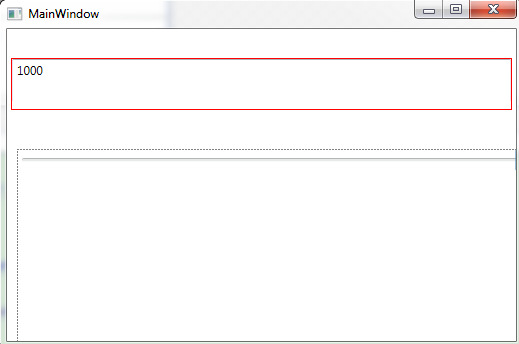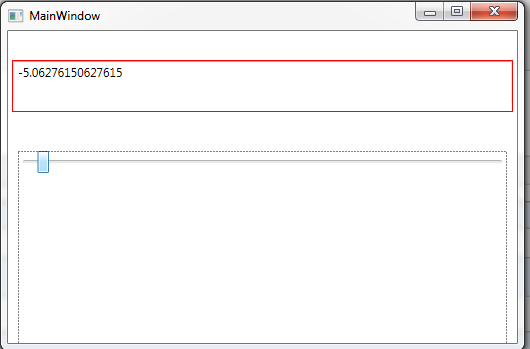一、概述
我们知道,Binding好比架设在Source和Target之间的桥梁,数据可以借助这个桥梁进行流通。在数据流通的过程中,我们可以在Binding这座桥梁上设置关卡,对数据的有效性进行验证。
二、验证方法
我们利用Binding的ValidationRules(类型为Collection<ValidationRule)对数据进行验证。从它的名称和类型可以得知,我们可以为每个Binding设置多个数据校验条件,每个条件是一个
ValidationRule对象,ValidationRule类是个抽象类,使用的时候,我们需要创建它的派生类并实现它的Validate方法。
Validate方法返回值是ValidationResult类型对象,如果校验通过,需要把ValidationResult对象的IsValid属性设置为true,反之,设置false并为其ErrorContent属性设置一个合适的消息内容,一般情况下是一个字符串。
三、例子
Demo1
假设UI上有一个Slider和一个TextBox,我们以Slider为源,TextBox为Target,Slider的取值范围为0~100,也就是说我们要需要校验TextBox中输入的值是不是在1~100这个范围内。

1 using System.Globalization; 2 using System.Windows; 3 using System.Windows.Controls; 4 5 namespace BindingDemo4ValidationRule 6 { 7 /// <summary> 8 /// Interaction logic for MainWindow.xaml 9 /// </summary> 10 public partial class MainWindow : Window 11 { 12 public MainWindow() 13 { 14 InitializeComponent(); 15 } 16 } 17 public class RangeValidationRule:ValidationRule 18 { 19 public override ValidationResult Validate(object value, CultureInfo cultureInfo) 20 { 21 double myValue = 0; 22 if(double.TryParse(value.ToString(),out myValue)) 23 { 24 if (myValue >= 0 && myValue <= 100) 25 { 26 return new ValidationResult(true, null); 27 } 28 } 29 return new ValidationResult(false, "Input should between 0 and 100"); 30 } 31 } 32 }

1 <Window x:Class="BindingDemo4ValidationRule.MainWindow" 2 xmlns="http://schemas.microsoft.com/winfx/2006/xaml/presentation" 3 xmlns:x="http://schemas.microsoft.com/winfx/2006/xaml" 4 xmlns:d="http://schemas.microsoft.com/expression/blend/2008" 5 xmlns:mc="http://schemas.openxmlformats.org/markup-compatibility/2006" 6 xmlns:local="clr-namespace:BindingDemo4ValidationRule" 7 mc:Ignorable="d" 8 Title="MainWindow" Height="350" Width="525"> 9 <Grid> 10 <Slider Margin="10,120,-10,-120" Minimum="0" Maximum="100" Name="slider" Value="10"></Slider> 11 <TextBox Height="50" Margin="5,30,5,240" > 12 <TextBox.Text> 13 <Binding ElementName="slider" Path="Value" UpdateSourceTrigger="PropertyChanged"> 14 <Binding.ValidationRules> 15 <local:RangeValidationRule/> 16 </Binding.ValidationRules> 17 </Binding> 18 </TextBox.Text> 19 </TextBox> 20 21 </Grid> 22 </Window>
运行结果如下:
从结果中可以看出,当我们在TextBox中输入的值不在0~100的范围内的时候,TextBox会显示红色边框,提示值是错误的。
Demo2
默认情况下,Binding校验默认来自Source的数据总是正确的,只有来自Target的数据(Target多为UI控件,等价于用户的输入)才有可能出现问题,为了不让有问题的数据污染Source,所以需要校验。换句话说,Binding只在Target被外部更新时候进行校验,而来自Binding的Source数据更新Target时是不会进行校验的。
当来自Source的数据也有可能出现问题的时候,我们需要将校验条件的ValidatesOnTargetUpdated属性设置为true。
我们把Xaml代码改为以下的时候,会发现当移动滑动条在0以下或者100以上的时候,TextBox边框也会变成红色。
1 <Window x:Class="BindingDemo4ValidationRule.MainWindow" 2 xmlns="http://schemas.microsoft.com/winfx/2006/xaml/presentation" 3 xmlns:x="http://schemas.microsoft.com/winfx/2006/xaml" 4 xmlns:d="http://schemas.microsoft.com/expression/blend/2008" 5 xmlns:mc="http://schemas.openxmlformats.org/markup-compatibility/2006" 6 xmlns:local="clr-namespace:BindingDemo4ValidationRule" 7 mc:Ignorable="d" 8 Title="MainWindow" Height="350" Width="525"> 9 <Grid> 10 <Slider Margin="10,120,10,-120" Minimum="-10" Maximum="110" Name="slider" Value="10"></Slider> 11 <TextBox Height="50" Margin="5,30,5,240" > 12 <TextBox.Text> 13 <Binding ElementName="slider" Path="Value" UpdateSourceTrigger="PropertyChanged"> 14 <Binding.ValidationRules> 15 <local:RangeValidationRule ValidatesOnTargetUpdated="True"/> 16 </Binding.ValidationRules> 17 </Binding> 18 </TextBox.Text> 19 </TextBox> 20 21 </Grid> 22 </Window>

Demo3
当校验发生错误的时候,Validate方法返回的ValidationResult对象会携带一条错误消息,下面我们就要显示这个错误消息。
为了达到这个目的,我们需要把Binding的NotifyOnValidationError属性设置为true,这样当数据校验失败的时候,Binding会像报警一样发出一个信号,这个信号会以Binding对象的Target为起点在UI树上传播,如果某个节点上设置了对这种信号的侦听器,那么这个侦听器就会触发来处理这个信号。详细参加以下代码:

1 using System.Globalization; 2 using System.Windows; 3 using System.Windows.Controls; 4 5 namespace BindingDemo4ValidationRule 6 { 7 /// <summary> 8 /// Interaction logic for MainWindow.xaml 9 /// </summary> 10 public partial class MainWindow : Window 11 { 12 public string TipMessage 13 { 14 get { return (string)GetValue(TipMessageProperty); } 15 set { SetValue(TipMessageProperty, value); } 16 } 17 18 // Using a DependencyProperty as the backing store for TipMessage. This enables animation, styling, binding, etc... 19 public static readonly DependencyProperty TipMessageProperty = 20 DependencyProperty.Register("TipMessage", typeof(string), typeof(MainWindow), new PropertyMetadata("Tip")); 21 22 public MainWindow() 23 { 24 InitializeComponent(); 25 this.DataContext = this; 26 } 27 28 private void tbx1_Error(object sender, ValidationErrorEventArgs e) 29 { 30 if (Validation.GetErrors(tbx1).Count > 0) 31 { 32 TipMessage = Validation.GetErrors(tbx1)[0].ErrorContent.ToString(); 33 } 34 else 35 { 36 TipMessage = ""; 37 } 38 } 39 } 40 public class RangeValidationRule : ValidationRule 41 { 42 public override ValidationResult Validate(object value, CultureInfo cultureInfo) 43 { 44 double myValue = 0; 45 if (double.TryParse(value.ToString(), out myValue)) 46 { 47 if (myValue >= 0 && myValue <= 100) 48 { 49 return new ValidationResult(true, null); 50 } 51 } 52 53 return new ValidationResult(false, "Input should between 0 and 100"); 54 } 55 } 56 }

1 <Window x:Class="BindingDemo4ValidationRule.MainWindow" 2 xmlns="http://schemas.microsoft.com/winfx/2006/xaml/presentation" 3 xmlns:x="http://schemas.microsoft.com/winfx/2006/xaml" 4 xmlns:d="http://schemas.microsoft.com/expression/blend/2008" 5 xmlns:mc="http://schemas.openxmlformats.org/markup-compatibility/2006" 6 xmlns:local="clr-namespace:BindingDemo4ValidationRule" 7 mc:Ignorable="d" 8 Title="MainWindow" Height="350" Width="525"> 9 <Grid> 10 <Slider Margin="10,120,10,-120" Minimum="-10" Maximum="110" Name="slider" Value="10"></Slider> 11 <TextBox Height="50" Margin="5,30,5,240" Name="tbx1" Validation.Error="tbx1_Error"> 12 <TextBox.Text> 13 <Binding ElementName="slider" Path="Value" UpdateSourceTrigger="PropertyChanged" NotifyOnValidationError="True"> 14 <Binding.ValidationRules> 15 <local:RangeValidationRule ValidatesOnTargetUpdated="True"/> 16 </Binding.ValidationRules> 17 </Binding> 18 </TextBox.Text> 19 </TextBox> 20 <Label Height="50" Margin="5,154,-5,116" Content="{Binding TipMessage}" Foreground="Red"> 21 22 </Label> 23 24 </Grid> 25 </Window>
运行结果以下:
